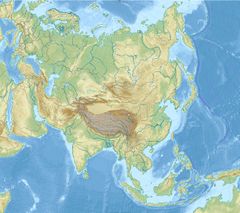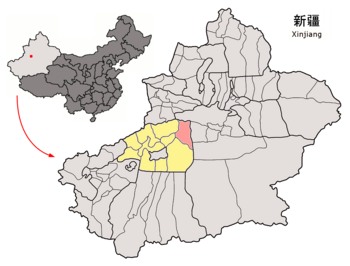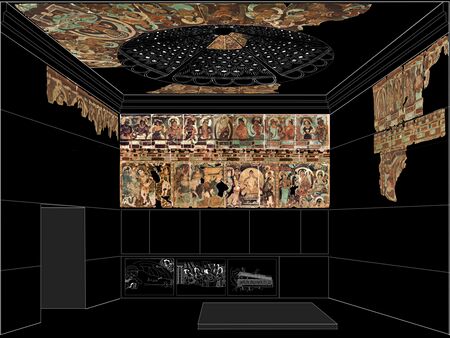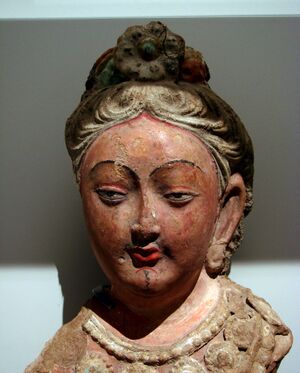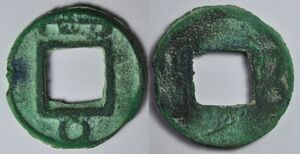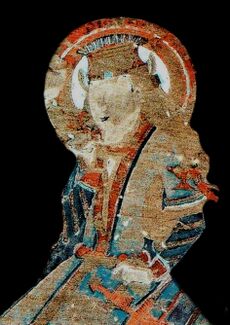كوچار
كوچار ؛ Kucha ؛ 龜茲 كوچار | |||||||
|---|---|---|---|---|---|---|---|
| قبل 111 م–648 م | |||||||
 حوض تاريم في القرن الثالث | |||||||
| الدين | Buddhism | ||||||
| صفة المواطن | Kuchean | ||||||
| التاريخ | |||||||
• تأسست | قبل 111 م | ||||||
| 648 م | |||||||
| التعداد | |||||||
• 111 CE | 81,317 | ||||||
| Currency | عملات كوچار | ||||||
| |||||||
| Today part of | China | ||||||
Kucha, or Kuche (also: Kuçar, Kuchar; ويغور: كۇچار, Кучар; Chinese: 龜茲; pinyin: Qiūcí also Chinese: 库车; pinyin: Kùchē; بالسنسكريتية: कूचीन),[1] was an ancient Buddhist kingdom located on the branch of the Silk Road that ran along the northern edge of what is now the Taklamakan Desert in the Tarim Basin and south of the Muzat River.
The area lies in present-day Aksu Prefecture, Xinjiang, China; Kuqa town is the county seat of that prefecture's Kuqa County. Its population was given as 74,632 in 1990.
أصل الاسم
The history of toponyms for modern Kucha remain somewhat problematic,[2] although it is clear that Kucha, Kuchar (in Turkic languages) and Kuché (modern Chinese),[3] correspond to the Kushan of Indic scripts from late antiquity.
While Chinese transcriptions of the Han or the Tang imply that Küchï was the original form of the name, Guzan (or Küsan), is attested in the Old Tibetan Annals (s.v.), dating from 687 CE.[4] Uighur and Chinese transcriptions from the period of the Mongol Empire support the forms Küsän / Güsän and Kuxian / Quxian respectively,[5] instead of Küshän or Kushan. Another, cognate Chinese transliteration is Ku-sien.[3]
Transcriptions of the name Kushan in Indic scripts from late antiquity include the spelling Guṣân, and are apparently reflected in at least one Khotanese-Tibetan transcription.[6]
The forms Kūsān and Kūs are attested in the 16th century work Tarikh-i-Rashidi.[7] Both names, as well as Kos, Kucha, Kujar etc., were used for modern Kucha.[3]
Chinese names of Kucha – 曲先; 屈支 屈茨; 丘慈 丘玆 邱慈; 俱支曩; 归兹; 拘夷; 苦叉 and; 姑藏 – have been romanized as Quxian, Quici, Chiu-tzu, Kiu-che, Kuei-tzu, Guizi, Juyi, Kucha, and Guzang. Although 龜玆 has sometimes been romanized as Qiuzi (or Wade-Giles: Ch'iu-tzu), this is generally regarded as incorrect; the second syllable is more properly represented as ci (Wade-Giles: tz'u).[8]
التاريخ
المملكة
For a long time, Kucha was the most populous oasis in the Tarim Basin. As a Central Asian metropolis, it was part of the Silk Road economy, and was in contact with the rest of Central Asia, including Sogdiana and Bactria, and thus also with the cultures of South Asia, Iran, and the coastal areas of China.[9] Its main population was Indo-European, part of the ancient population of the Tarim Basin known as Tocharians, and they spoke an Indo-European language known as Tocharian.[10] Chinese sources from the 2nd century BCE did mention Indo-European Wusun populations with blue eyes and red hair in the area of the Ili river, to the northwest of Kucha. [10] Zhang Qian traveled the area westward to visit Central Asia, during the 2nd century BCE, stopping at Kucha. The Roman Maes Titianus is known to have visited the area in the 2nd century CE.[10] According to the Book of Han (completed in 111 CE), Kucha was the largest of the "Thirty-six Kingdoms of the Western Regions", with a population of 81,317, including 21,076 persons able to bear arms.[11] The Kingdom of Kucha occupied a strategic position on the Northern Silk Road, which brought it prosperity, and made it a wealthy center of trade and culture.[12]
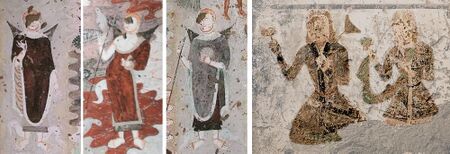
During the Later Han (25–220 CE), Kucha, with the whole Tarim Basin, became a focus of rivalry between the Xiong-nu to the north and the Chinese to the east.[14] In 74 CE, Chinese troops started to take control of the Tarim Basin with the conquest of Turfan.[15] During the 1st century CE, Kucha resisted the Chinese invasion, and allied itself with the Xiong-nu and the Yuezhi against the Chinese general Ban Chao.[16] Even the Kushan Empire of Kujula Kadphises sent an army to the Tarim Basin to support Kucha, but they retreated after minor encounters.[16]
In 124, Kucha formally submitted to the Chinese court, and by 127 China had conquered the whole of the Tarim Basin.[17] Kucha became a part of the Western protectorate of the Chinese Han Dynasty, with China's control of the Silk Road facilitating the exchange of art and the propagation of Buddhism from Central Asia.[18] The Roman Maes Titianus visited the area in the 2nd century CE,[19] as did numerous great Buddhist missionaries such as the Parthian An Shigao, the Yuezhis Lokaksema and Zhi Qian, or the Indian Chu Sho-fu (竺朔佛).[20] Around 150 CE, Chinese power in the western territories receded, and the Tarim Basin and its city-states regained independence.[21][22]
Kucha became very powerful and rich in the last quarter of the 4th century CE, about to take over most of the trade along the Silk Road at the expense of the Southern Silk Road, which lay along the southern edge of the Tarim Basin.[12] According to the Jinshu, Kucha was highly fortified, had a splendid royal palace, as well as many Buddhist stupas and temples:[26]
There are fortified cities everywhere, their ramparts are three-fold, inside there are thousands of Buddhist stupas and temples (...) The royal palace is magnificent, glowing like a heavenly abode".
Culture flourished, and Indian Sanskrit scriptures were being translated by the Kuchean monk and translator Kumarajiva (344-413 CE), himself the son of a man from Kashmir and a Kuchean mother.[12] The southern kingdoms of Shan-shan and Jushi (Turfan and Jiaohe}) asked for Chinese assistance in countering Kucha and its neighbour Karashar.[12] The Chinese general Lü Guang was sent with a military force by Emperor Fu Jian (357-385) of the Former Qin Dynasty (351-394).[12] Lu-Guang obtained the surrender of Karashar and conquered Kucha in 383 CE.[12] Lu-Guang mentioned the powerful armour of Kucha soldiers, a type of Sasanian chainmail and lamellar armour which can also be seen in the paintings of the Kizil Caves:[12]
They were skillful with arrows and horses, and good with short and long spears. Their armour was like chain link; even if one shoots it, [the arrow] cannot go in.
Lu-Guang soon retired and the empire of Fu Jian crumbled against the Eastern Jin, and he established his own principality in Gansu, bringing Kumarajiva together with him.[12]

Kucha ambassadors are known to have visited the Chinese court of Emperor Yuan of Liang in his capital Jingzhou in 516–520 CE, at or around the same time as the Hepthalite embassies there. An ambassador from Kucha is illustrated in Portraits of Periodical Offering of Liang, painted in 526-539 CE, an 11th century Song copy of which as remained.
The Chinese pilgrim Xuanzang visited Kucha and in the 630s described Kucha at some length, and the following are excerpts from his descriptions of Kucha:
The soil is suitable for rice and grain... it produces grapes, pomegranates and numerous species of plums, pears, peaches, and almonds... The ground is rich in minerals-gold, copper, iron, and lead and tin. The air is soft, and the manners of the people honest. The style of writing is Indian, with some differences. They excel other countries in their skill in playing on the lute and pipe. They clothe themselves with ornamental garments of silk and embroidery... There are about one hundred convents in this country, with five thousand and more disciples. These belong to the Little Vehicle of the school of the Sarvastivadas. Their doctrine and their rules of discipline are like those of India, and those who read them use the same originals... About 40 li to the north of this desert city there are two convents close together on the slope of a mountain... Outside the western gate of the chief city, on the right and left side of the road, there are erect figures of Buddha, about 90 feet high.[28][29][30]

A specific style of music developed within the region and "Kuchean" music gained popularity as it spread along the trade lines of the Silk Road. Lively scenes of Kuchean music and dancing can be found in the Kizil Caves and are described in the writings of Xuanzang. "[T]he fair ladies and benefactresses of Kizil and Kumtura in their tight-waisted bodices and voluminous skirts recall--notwithstanding the Buddhic theme--that at all the halting places along the Silk Road, in all the rich caravan towns of the Tarim, Kucha was renowned as a city of pleasures, and that as far as China men talked of its musicians, its dancing girls, and its courtesans."[34] Kuchean music was very popular in Tang China, particularly the lute, which became known in Chinese as the pipa.[35] For example, within the collection of the Guimet Museum, two Tang female musician figures represent the two prevailing traditions: one plays a Kuchean pipa and the other plays a Chinese jiegu (an Indian-style drum).[36] The music of Kucha, along with other early medieval music, was transmitted from China to Japan during the same period and is preserved there, somewhat transformed, as gagaku or Japanese court music.[37]
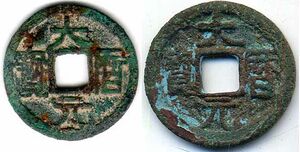
فتح الهان لكوچار
Following its conquest by the Tang dynasty in the 7th century, during Emperor Taizong's campaign against the Western Regions, the city of Kucha was regarded by Han Chinese as one of the Four Garrisons of Anxi: the "Pacified West",[38] or even its capital. During periods of Tibetan domination it was usually at least semi-independent. It fell under Uyghur domination and became an important center of the later Uyghur Kingdom of Qocho after the Kyrgyz destruction of the Uyghur steppe empire in 840.[39]
The extensive ruins of the ancient capital and temple of Subashi (Chinese Qiuci), which was abandoned in the 13th century, lie 20 kilometres (12 mi) north of modern Kucha.
كوچار الحديثة
Francis Younghusband, who passed through the oasis in 1887 on his journey from Beijing to India, described the district as "probably" having some 60,000 inhabitants. The modern Chinese town was about 700 square yards (590 m2) with a 25 feet (7.6 m) high wall, with no bastions or protection to the gateways, but a ditch about 20 feet (6.1 m) deep around it. It was filled with houses and "a few bad shops". The "Turk houses" ran right up to the edge of the ditch and there were remains of an old city to the south-east of the Chinese one, but most of the shops and houses were outside of it. About 800 yards (730 m) north of the Chinese city were barracks for 500 soldiers out of a garrison he estimated to total about 1,500 men, who were armed with old Enfield rifles "with the Tower mark."[40]
Modern Kucha is part of Kuqa County, Xinjiang. It is divided into the new city, which includes the People's Square and transportation center, and the old city, where the Friday market and vestiges of the past city wall and cemetery are located. Along with agriculture, the city also manufactures cement, carpets and other household necessities in its local factories.[بحاجة لمصدر]
التنقيب الأثري
There are several significant archaeological sites in the region which were investigated by the third (1905–1907, led by Albert Grünwedel) and fourth (1913–1914, led by Albert von Le Coq) German Turfan expeditions.[41][42] Those in the immediate vicinity include the cave site of Achik-Ilek and Subashi.
كوچار والبوذية
Kucha was an important Buddhist center from Antiquity until the late Middle Ages. Buddhism was introduced to Kucha before the end of the 1st century, however it was not until the 4th century that the kingdom became a major center of Buddhism,[43] primarily the Sarvastivada, but eventually also Mahayana Buddhism during the Uighur period. In this respect it differed from Khotan, a Mahayana-dominated kingdom on the southern side of the desert.
According to the Book of Jin, during the third century there were nearly one thousand Buddhist stupas and temples in Kucha. At this time, Kuchanese monks began to travel to China. The fourth century saw yet further growth for Buddhism within the kingdom. The palace was said to resemble a Buddhist monastery, displaying carved stone Buddhas, and monasteries around the city were numerous.
Kucha is well known as the home of the great fifth-century translator monk Kumārajīva (344-413).
الرهبان
پو-ين
A monk from the royal family known as Po-Yen travelled to the Chinese capital, Luoyang, from 256-260. He translated six Buddhist texts into Chinese in 258 at China's famous White Horse Temple, including the Infinite Life Sutra, an important sutra in Pure Land Buddhism.[بحاجة لمصدر]
پو-شريميترا
Po-Śrīmitra was another Kuchean monk who traveled to China from 307-312 and translated three Buddhist texts.
پو-ين
A second Kuchean Buddhist monk known as Po-Yen also went to Liangzhou (modern Wuwei, Gansu, China) and is said to have been well respected, although he is not known to have translated any texts.
اللغات التخارية
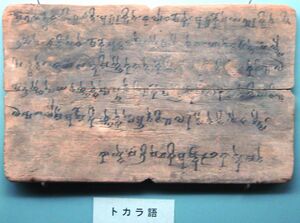
The language of Kucha, as evidenced by surviving manuscripts and inscriptions, was Kuśiññe (Kushine) also known as Tocharian B or West Tocharian, an Indo-European language. Later, under the Uighur domination, the Kingdom of Kucha gradually became Turkic speaking. Kuśiññe was completely forgotten until the early 20th century, when inscriptions and documents in two related (but mutually unintelligible) languages were discovered at various sites in the Tarim Basin. Conversely, Tocharian A, or Ārśi was native to the region of Turpan (known later as Turfan) and Agni (Qarašähär; Karashar), although the Kuśiññe language also seems to have been spoken there.
While they were written in a Central Asian Brahmi script used typically for Indo-Iranian languages, the Tocharian languages (as they became known by modern scholars) belonged to the centum group of Indo-European languages, which are otherwise native to southern and western Europe. The precise dating of known Tocharian texts is contested, but they were written around the 6th to 8th centuries CE (although Tocharian speakers must have arrived in the region much earlier). Both languages became extinct before circa 1000 CE. Scholars are still trying to piece together a fuller picture of these languages, their origins, history and connections, etc.[44]
الجيران
The kingdom bordered Aksu and Kashgar to the west and Karasahr and Turpan to the east. Across the Taklamakan Desert to the south was Khotan.
كوچار وكهوف قزل
The Kizil Caves lie about 70 kilometres (43 mi) northwest of Kucha and were included within the rich fourth-century kingdom of Kucha. The caves claim origins from the royal family of ancient Kucha, specifically a local legend involving Princess Zaoerhan, the daughter of the King of Kucha. While out hunting, the princess met and fell in love with a local mason. When the mason approached the king to ask for permission to marry the princess, the king was appalled and vehemently against the union. He told the young man he would not grant permission unless the mason carved 1000 caves into the local hills. Determined, the mason went to the hills and began carving in order to prove himself to the king. After three years and carving 999 caves, he died from the exhaustion of the work. The distraught princess found his body, and grieved herself to death, and now, her tears are said to be current waterfalls that cascade down some of the cave's rock faces.[45]
العملات
From around the third or fourth century Kucha began the manufacture of Wu Zhu (五銖) cash coins inspired by the diminutive and devalued Wu Zhu's of the post-Han dynasty era in Chinese history. It is very likely that the cash coins produced in Kucha predate the Kaiyuan Tongbao (開元通寳) and that the native production of coins stopped sometime after the year 621 when the Wu Zhu cash coins were discontinued in China proper.[46] The coinage of Kucha includes the "Han Qiu bilingual Wu Zhu coin" (漢龜二體五銖錢, hàn qiū èr tǐ wǔ zhū qián) which has a yet undeciphered text belonging to a language spoken in Kucha.[47][48]
خط زمني
- 630: شوانزانگ زار المملكة.
الحكام
(Names are in modern Mandarin pronunciations based on ancient Chinese records)
- Hong (弘) 16
- Cheng De (丞德) 36
- Ze Luo (則羅) 46
- Shen Du (身毒) 50
- Jiang Bin (絳賓) 72
- Jian (建) 73
- You Liduo (尤利多) 76
- Bai Ba (白霸) 91
- Bai Ying (白英) 110-127
- Bai Shan (白山) 280
- Long Hui (龍會) 326
- Bai Chun (白純) 349
- Bai Zhen (白震) 382
- Niruimo Zhunashen (尼瑞摩珠那勝) 521
- Bai Sunidie (白蘇尼咥) 562
- Anandavarman ?
- Tottika (circa 550-600)
- Suvarnapushpa (白蘇伐勃駃 Bái Sūfábókuài) 600-625[49]
- Suvarnadeva (白蘇伐疊 Bai Sufadie) 625-645[49]
- Haripuspa (白訶黎布失畢, Bai Helibushibi) 647[49]
- Bai Yehu (白葉護) 648
- Bai Helibushibi (白訶黎布失畢) 650
- Bai Suji (白素稽) 659
- Yan Tiandie (延田跌) 678
- Bai Mobi (白莫苾) 708
- Bai Xiaojie (白孝節) 719
- Bai Huan (白環) 731-789? / Tang general - Guo Xin 789
انظر أيضاً
- Ci poetry
- Kushan Empire
- Silk Road numismatics
- Silk Road transmission of Buddhism
- Subashi (lost city)
المراجع
- ^ "中印佛教交通史". Archived from the original on 2016-03-03. Retrieved 2011-03-20.
- ^ Beckwith 2009, p. 381, n=28.
- ^ أ ب ت Elias (1895), p. 124, n. 1.[استشهاد ناقص]
- ^ Beckwith 1993, p. 50.
- ^ Yuanshi, chap. 12, fol 5a, 7a.[استشهاد ناقص]
- ^ Beckwith 1993, p. 53.
- ^ cf. Elias and Ross, Tarikh-i-Rashidi, in the index, s.v. Kuchar and Kusan: "One m.s. [of the Tarikh-i-Rashidi] reads Kus / Kusan.
- ^ Hill 2015, Vol. I, p. 121, note 1.30.
- ^ Beckwith 2009, p. xix ff.
- ^ أ ب ت Grousset 1970, p. 40.
- ^ Hulsewé 1979, p. 163, n. 506.
- ^ أ ب ت ث ج ح خ د ذ Baumer, Christoph (18 April 2018). History of Central Asia, The: 4-volume set. Bloomsbury Publishing. pp. 158 ff. ISBN 978-1-83860-868-2.
- ^ Rhie, Marylin Martin (15 July 2019). Early Buddhist Art of China and Central Asia, Volume 2 The Eastern Chin and Sixteen Kingdoms Period in China and Tumshuk, Kucha and Karashahr in Central Asia. BRILL. pp. 651 ff. ISBN 978-90-04-39186-4.
- ^ Grousset 1970, p. 40-47.
- ^ Grousset 1970, p. 42.
- ^ أ ب Grousset 1970, p. 45-46.
- ^ Grousset 1970, p. 48.
- ^ Grousset 1970, p. 47-48.
- ^ Grousset 1970, p. 40, 48.
- ^ Grousset 1970, pp. 49 ff.
- ^ Hansen 2012, p. 66.
- ^ Millward 2007, pp. 22–24.
- ^ Altbuddhistische Kultstätten in Chinesisch-Turkistan: vol. 1. pp. 87 ff / p. 93 (Color Image).
- ^ Grünwedel, Albert (1920). Alt-Kutscha. pp. 251 ff (Doppeltafel Tafel I, II – Fig. 1, Fig. 2) – via National Institute of Informatics - Digital Silk Road Project: Digital Archive of Toyo Bunko Rare Books. Also black and white 1912 photograph.
- ^ Zin, Monika (2015). "The Case of the "Repainted Cave" (Kizil, Cave 117)". Indo-Asiatische Zeitschrift. 19: 23 – via docplayer.org.
- ^ Puri, Baij Nath (1987). Buddhism in Central Asia. Motilal Banarsidass Publ. p. 80. ISBN 978-81-208-0372-5.
- ^ 俗有城郭,其城三重,中有佛塔廟千所...王宮壯麗,煥若神居。 in the account of Kucha (龜茲國) in "晉書/卷097". zh.wikisource.org.
- ^ Daniel C. Waugh. "Kucha and the Kizil Caves". Silk Road Seattle. University of Washington.
- ^ Beal, Samuel (2000). Si-yu-ki: Buddhist Records of the Western World : Translated from the Chinese of Hiuen Tsiang (A.D. 629). Psychology Press. pp. 19–20. ISBN 978-0-415-24469-5.
- ^ ""屈支国" in 大唐西域记/01 - 维基文库,自由的图书馆". zh.m.wikisource.org. Wikisource.
- ^ "俄立艾爾米塔什博物館藏克孜爾石窟壁畫". www.sohu.com (in الصينية). References BDce-888、889, MIK III 8875, now in the Hermitage Museum.
- ^ Yaldiz, Marianne (1987). Archèaologie und Kunstgeschichte Chinesisch-Zentralasiens (Xinjiang) (in الألمانية). BRILL. p. xv Image 16. ISBN 978-90-04-07877-2.
- ^ Ghose, Rajeshwari (2008). Kizil on the Silk Road: Crossroads of Commerce & Meeting of Minds. Marg Publications. p. 127, note 22. ISBN 978-81-85026-85-5.
The images of donors in Cave 17 are seen in two fragments with numbers MIK 8875 and MIK 8876. The person with the halo may be identified as a king of Kucha.
- ^ Grousset 1970, p. 98.
- ^ Schafer 1963, p. 52.
- ^ Whitfield 2004, p. 254-255.
- ^ Picken 1997, p. 86.
- ^ Beckwith 1993, p. 198.
- ^ Beckwith 2009, p. 157 ff.
- ^ Younghusband 1904, p. 152.
- ^ Le Coq, Albert (1922–1933). Die Buddhistische Spätantike in Mittelasien. Ergebnisse der Kgl. Preussischen Turfan-Expeditionen. Berlin.
{{cite book}}: CS1 maint: location missing publisher (link) - ^ "German Collections". International Dunhuang Project. Retrieved 23 October 2012.
- ^ Buswell, Robert Jr; Lopez, Donald S. Jr., eds. (2013). "Kucha", in Princeton Dictionary of Buddhism. Princeton, NJ: Princeton University Press. p. 449. ISBN 9780691157863.
- ^ Mallory & Mair 2008, pp. 270-296, 333-334.
- ^ Ondřej Klimeš (2004). "XINJIANG CAST CASH IN THE COLLECTION OF THE NÁPRSTEK MUSEUM, PRAGUE" (PDF). Annals of the Náprstek Museum. 25: 109–122. Archived from the original (PDF) on 2018-08-28. Retrieved 28 August 2018.
- ^ Vladimir Belyaev (11 February 2002). "Xinjiang, Qiuzi Kingdom - Bilingual Cash Coins". Charm.ru. Retrieved 25 August 2018.
- ^ Gary Ashkenazy (16 November 2016). "Chinese coins – 中國錢幣 § Qiuci Kingdom (1st-7th centuries)". Primal Trek. Archived from the original on 2018-09-01. Retrieved 1 September 2018.
- ^ أ ب ت Peyrot, Michaël (2008). Variation and change in Tocharian B. BRILL. pp. 196, 199–200. ISBN 978-90-04-35821-8.
ببليوگرافيا
- Beckwith, Christopher (1993) [1987]. The Tibetan Empire in Central Asia: A History of the Struggle for Great Power Among Tibetans, Turks, Arabs, and Chinese During the Early Middle Ages (reprint ed.). Princeton University Press. ISBN 0-691-02469-3.
- Beckwith, Christopher I. (2009). Empires of the Silk Road: A History of Central Eurasia from the Bronze Age to the Present. Princeton University Press. ISBN 978-0-691-13589-2.
- Grousset, René (1970). The Empire of the Steppes: A History of Central Asia. Rutgers University Press. ISBN 978-0-8135-1304-1. Google Books
- Hansen, Valerie (2012). The Silk Road. Oxford University Press. ISBN 978-0-195-15931-8.
- Hill, John Edward (2015). Through the Jade Gate - China to Rome. A Study of the Silk Routes 1st to 2nd Centuries CE. Vol. I. North Charleston, S.C.: CreateSpace. pp. 121–125, note 1.30. ISBN 978-1500696702.
- Hulsewé, Anthony François Paulus Hulsewé (1979). China in Central Asia: The Early Stage: 125 BC - AD 23 ; an Annotated Transl. of Chapters 61 and 96 of the History of the Former Han Dynasty. With an Introd. by M.A.N.Loewe. Brill Archive. ISBN 90-04-05884-2.
- Mallory, J. P.; Mair, Victor H. (2008). The Tarim Mummies: Ancient China and the Mystery of the Earliest Peoples from the West. Thames & Hudson. ISBN 978-0-500-28372-1.
- Millward, James A. (2007). Eurasian Crossroads: A History of Xinjiang. Columbia University Press. ISBN 978-0-231-13924-3.
- Picken, Laurence (1997). Music from the Tang Court (PDF). Vol. 7. Cambridge University Press. ISBN 978-0-521-62100-7.
- Schafer, Edward H. (1963). The Golden Peaches of Samarkand: A Study of Tʻang Exotics. University of California Press. ISBN 978-0-520-05462-2.
- Tredinnick, Jeremy; Baumer, Christoph; Bonavia, Judy (2012). Xinjiang: China's Central Asia. Odyssey. ISBN 978-962-217-790-1.
- Whitfield, Susan (2004). The Silk Road: Trade, Travel, War and Faith. Serindia Publications, Inc. ISBN 978-1-932476-13-2.
- Younghusband, Francis (1904). The Heart of a Continent: A Narrative of Travels in Manchuria, Across the Gobi Desert, Through the Himalayas, the Pamirs, and Hunza, 1884-1894. Scribner.
المصادر الرئيسية
- The Book of Han
- The Book of the Later Han
- The Book of Jin
وصلات خارجية
- Silk Road Seattle - University of Washington (The Silk Road Seattle website contains many useful resources including a number of full-text historical works)
- Kucha at Google Maps
- Pages using gadget WikiMiniAtlas
- Articles with incomplete citations from August 2021
- All articles with incomplete citations
- CS1 الصينية-language sources (zh)
- CS1 الألمانية-language sources (de)
- CS1 maint: location missing publisher
- Short description is different from Wikidata
- Articles containing traditional Chinese-language text
- Articles containing سنسكريتية-language text
- Articles with hatnote templates targeting a nonexistent page
- Articles with unsourced statements from June 2020
- Articles with unsourced statements from August 2015
- Ancient peoples of China
- بلدان سابقة في التاريخ الصيني
- Central Asian Buddhist kingdoms
- Central Asian Buddhist sites
- أماكن مأهولة على طريق الحرير
- Populated places in Xinjiang
- واحات الصين
